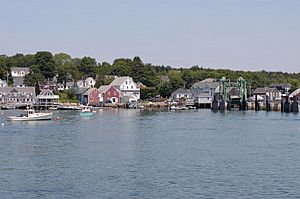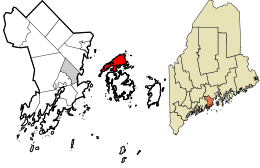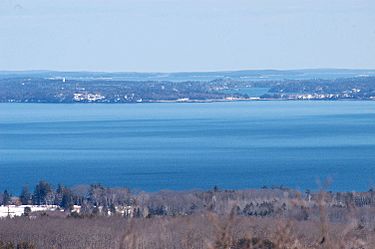North Haven, Maine facts for kids
Quick facts for kids
North Haven, Maine
|
|
|---|---|

Harborfront and ferry terminal, 2005
|
|

Location in Knox County and the state of Maine
|
|
| Country | United States |
| State | Maine |
| County | Knox |
| Incorporated | 1846 |
| Area | |
| • Total | 82.49 sq mi (213.65 km2) |
| • Land | 11.62 sq mi (30.10 km2) |
| • Water | 70.87 sq mi (183.55 km2) |
| Elevation | 0 ft (0 m) |
| Population
(2020)
|
|
| • Total | 417 |
| • Density | 36/sq mi (13.9/km2) |
| Time zone | UTC−5 (Eastern (EST)) |
| • Summer (DST) | UTC−4 (EDT) |
| ZIP Code |
04853
|
| Area code(s) | 207 |
| FIPS code | 23-51620 |
| GNIS feature ID | 0582633 |
North Haven is a small town located on an island in Knox County, Maine, USA. It sits in Penobscot Bay. This island is home to people all year, but it's also a popular spot for summer visitors. In 2020, about 417 people lived here. You can get to North Haven by taking a state ferry from Rockland (it runs three times a day) or by a small air taxi plane from Knox County Regional Airport.
Contents
Island History: From Ancient Times to Today
Early Visitors and Explorers
Long ago, around 3300 BCE, the island was visited by a group of people known as the Red Paint People. Later, the Penobscot Abenaki Indians used the island for hunting and fishing. They traveled in canoes along the coast.
In 1603, an explorer from England named Captain Martin Pring "discovered" North Haven. He also found Vinalhaven. He called both islands the Fox Islands. This name is still used for the Fox Islands Thoroughfare, a narrow water passage between the islands. It's a popular route for boats in Penobscot Bay.
Becoming a Town
People started settling on North Haven in the 1760s. It was first known as the North Island of Vinalhaven. On June 30, 1846, it officially became its own town called Fox Isle. The name was changed to North Haven on July 13, 1847.
In 1850, the state government passed a law about roads. It said that most island residents could decide what kind of roads they wanted. Many decided they didn't want any roads at all, or they wanted roads with gates. This caused some disagreements, and a smaller group of residents asked for the law to be changed.
Island Jobs and Industries
In the past, fishing and farming were the main jobs on North Haven. Farmers grew hay as a key crop. Boatbuilding also became very important. The island still has two boatyards today. Many people were fishermen, catching lobsters, scallops, and oysters.
North Haven's Summer Colony
In the 1880s, people from cities like Boston, New York, and Philadelphia discovered North Haven. They were called "rusticators" and came to the island for the summer. Today, North Haven is well-known for its large summer colony. Many wealthy families from the Northeast, especially from Boston, have been coming here for over a century. They love the island's simple way of life.
A famous artist named Frank Weston Benson was one of these summer residents. He rented a farm and painted many well-known pictures inspired by the island.
The southern part of the Fox Islands Thoroughfare is often thought of as part of North Haven. This is because Vinalhaven's north shore is quite far from its own town center. North Haven's economy relies more on its summer visitors than on the lobster industry. The island gets some of its electricity from a wind project on Vinalhaven. Even though it's a popular place, North Haven has only a few places for tourists. There are two inns, a grocery store, two seasonal restaurants, a pizza shop, and two gift shops. It's mostly for people who own vacation homes there.
Interestingly, a small group of Mouflon sheep (which are native to Europe and Asia) escaped from an animal area owned by Thomas Watson, Jr. in the 1990s. Some of these sheep still live on the island today!
North Haven Dinghy: A Racing Tradition
In 1885, a man named William Weld challenged the yachtsmen of North Haven to a boat race. He used a small boat, called a tender, from his yacht. He didn't win against the local boats. So, that winter, he had a better small boat, a dinghy, designed and built in Salem, Massachusetts. The next year, he won against everyone!
His boat was brought to North Haven, and two copies were made by Henry Calderwood. The next race was between three women: Mrs. Cobb, Miss Spencer, and Miss Hayward. The first boats used a type of sail called a spritsail, but soon they switched to gaff rigs. In 1888, James Osman Brown built four more dinghies. This was the start of the J. O. Brown & Sons boatyard. More and more dinghies were built for racing over the years. They are still raced today at North Haven's sailing club, the North Haven Casino. This makes them the oldest continuously raced boat class in the United States!
Geography: Where North Haven Is Located
North Haven is an island in Penobscot Bay and the Gulf of Maine, which is part of the Atlantic Ocean. The town covers about 82.49 square miles (213.65 square kilometers). Most of this area is water (70.87 sq mi or 183.55 sq km), and 11.62 square miles (30.10 sq km) is land. At its widest points, the island is about 7.9 miles (12.7 km) long and 2.9 miles (4.7 km) wide.
Population Information
| Historical population | |||
|---|---|---|---|
| Census | Pop. | %± | |
| 1850 | 806 | — | |
| 1860 | 951 | 18.0% | |
| 1870 | 806 | −15.2% | |
| 1880 | 755 | −6.3% | |
| 1890 | 552 | −26.9% | |
| 1900 | 551 | −0.2% | |
| 1910 | 535 | −2.9% | |
| 1920 | 510 | −4.7% | |
| 1930 | 476 | −6.7% | |
| 1940 | 460 | −3.4% | |
| 1950 | 410 | −10.9% | |
| 1960 | 384 | −6.3% | |
| 1970 | 399 | 3.9% | |
| 1980 | 373 | −6.5% | |
| 1990 | 332 | −11.0% | |
| 2000 | 381 | 14.8% | |
| 2010 | 355 | −6.8% | |
| 2020 | 417 | 17.5% | |
| U.S. Decennial Census | |||
North Haven's Population in 2010
According to the census from 2010, 355 people lived in North Haven. There were 165 households and 105 families. The population density was about 30.6 people per square mile (11.8 per square kilometer). There were 515 housing units in total.
Most of the people (96.9%) were White. A small number were African American (0.3%), Asian (0.3%), or from other races (0.6%). About 2.0% of the population identified with two or more races. People of Hispanic or Latino background made up 2.3% of the population.
Out of the 165 households, 23.0% had children under 18 living there. About 49.1% were married couples living together. The average household had 2.15 people, and the average family had 2.62 people.
The average age of people in North Haven was 44.5 years old. About 20% of residents were under 18. About 19.4% were 65 or older. The population was almost evenly split between males (52.4%) and females (47.6%).
Education: North Haven Community School
North Haven is special among Maine island communities because it has a school for all grades, from kindergarten to 12th grade. Most other islands only have elementary schools, and their older students go to high school on the mainland. (Other islands with K-12 schools include Vinalhaven, Mount Desert Island, Deer Isle, and Islesboro).
The North Haven Community School is one of Maine's smallest public schools. Its motto is "Competence, Compassion, Challenge and Community." A notable former student is Hannah Pingree, who later became the Speaker of the Maine House of Representatives.
Notable People from North Haven
- Angela Adams, a designer
- Frank Weston Benson, an artist who had a summer home here
- Harold Beverage, an electrical engineer and inventor
- Elizabeth Bishop, a famous poet
- Jonathan Bush, a banker
- Henry N. Cobb, an architect
- Pierre S. du Pont IV, a politician
- J. Christopher Flowers, a banker
- Eric Hopkins, a painter
- Ned Lamont, the current Governor of Connecticut
- Burke Marshall, a lawyer and professor
- Susan Minot, a writer
- Robert Montgomery, an actor and father of Elizabeth Montgomery
- Dwight Morrow, an ambassador
- Chellie Pingree, a U.S. representative
- Hannah Pingree, a former speaker of the Maine House of Representatives
- Nicholas Platt, a U.S. ambassador
- Oliver Platt, an actor
- Matthew Simmons, an investment banker
- John Sirica, a U.S. District Court Judge known for the Watergate case
- Herbert Eustis Winlock, an Egyptologist
- Wilford Woodruff, the 4th president of the LDS Church, lived here for a time
See also
 In Spanish: North Haven (Maine) para niños
In Spanish: North Haven (Maine) para niños


